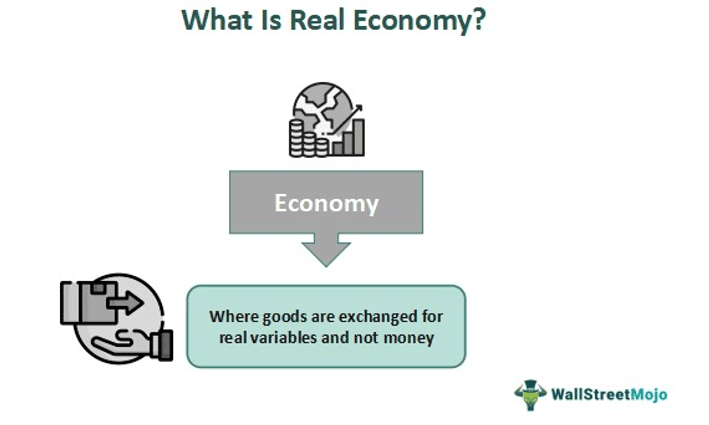When it comes to defining an economy, there are different terms to define different types of economy. Among them, the two widely used ones are the real economy and financial economy, which exhibit multiple differences. Let us have a look at the comparison between the two in brief below:
Table of Contents
What Is The Real Economy?
Real Economy refers to an economy where the exchange of products and services is done for real variables or elements, including the output the other party produces. It is different from standard economies, where goods and services are bought solely in exchange for money. Other real elements for which the goods can be bought may include production, transportation, etc.

While the barter system, in ancient times, perfectly represented the real economy, it never required an underlying monetary system. Through barter, people used to exchange one item for another, mainly those difficult to find in their respective regions. On the other hand, the real type of economy today involves the exchange of goods for anything that reflects the underlying monetary system.
Key Takeaways
- The real economy refers to the place of exchange of goods and services for anything guided by an underlying monetary system. The real part goes beyond it and includes production, transportation, and the sale of goods and services.
- The economy is addressed as real because it is something real people can experience in their pockets, such as money's worth, economic growth, recession, inflation, etc.
- The real economic conditions are measured and visualized through indices such as GDP, interest rates, and prices.
Real Economy Explained
The real economy comprises businesses, households, and other organizations producing goods and services, and it is the system where the participants exchange items for other items or facilities backed by a monetary system. The item a product gets exchanged for, in such cases, is not direct money, but they do reflect the monetary value of the latter. An economic activity is regarded as real as it uses actual resources to create goods people can purchase and use.
The idea of real economy and exchange began with the classical labor theory in the nineteenth century. It provided a quantifiable, stable component as a measurement unit for exchanges that occurred. However, towards the twentieth century, capital became the key component of land, labor, and capital. The period gradually saw the concept of real being applied to the purchasing power of money related to production over time and their corresponding wages. They were termed real prices and real wages, respectively.
Subsequently, indices such as the Consumer Price Index (CPI) and gross domestic product (GDP) were used to track economic life. Factors such as money's purchasing power and inflation, which result in the decline of real wages and a possible increase in the cost of living, became the reflection of real life as led by consumers. The concept of real, hence, became a measure of inflation.
This concept of economic governance was developed to track the relationship between money and the goods and services produced over various timelines. It is done to analyze the monetary valuations that fluctuate for varied reasons. The economy is addressed as real because it is something real people can experience in their pockets, such as money's worth, economic growth, recession, inflation, etc. The concept is measured and visualized through indices such as GDP, interest rates, and prices. The concept helps us understand how stability can be achieved; money is kept in circulation, and lives are improved by formulating necessary policies.
Examples
Let us understand the real economy definition and its financing using the scenarios below:
Example #1
The real economy consists of production, sales, transportation, etc. The parties involved are businesses, people, and investors, and to ensure the robust functioning of all the parties and the economy as a whole, it is essential to fund it. The European Long-Term Investment Framework (ELTIF) is an investment policy that aims to work for the benefit of the above parties.
The ELTIF is a pan-European regulatory framework for alternative investment funds (AIFs). It directs the capital it generates toward long-term investments in Europe's real economy, in accordance with the European Union's (EU) goal of smart, sustainable, and inclusive development. It wants to create a single market for capital for the benefit of the parties by helping with investments and savings flows across the EU member states.
Example #2
A May 2024 Forbes article discussed how the tightened monetary policies of the Federal Reserve have effectively controlled inflation but couldn’t stop it from impacting the real economy. As this type of economy is based on the production and manufacturing sectors being assessed on outputs, the decline in the performance of the manufacturing sector raised concern. The ISM Manufacturing Index has been witnessing considerable contraction to almost less than 50 in the last one and a half years. The industry is still struggling to regain its position, which indicates difficulties for a real economy to survive as it is an output-driven economy.
Real Economy vs Financial Economy
| Key Points | Real Economy | Financial Economy |
|---|---|---|
| 1. Concept | The term refers to a broader version of economics that involves the production and sale of goods in exchange for real variables backed by or free from the underlying monetary system. | The financial economy is the embodiment of a marketplace constituting financial instruments. |
| 2. Components | This comprises goods and services, investments such as land and buildings, equipment, etc. | The financial economy involves activities dealing with shares, bonds, securities, and other such instruments. |
| 3. Purpose or use | The real economy is concerned with production. It plays a vital role in the flow of money in the economy. | Financial instruments provide the real economy with the resources that can keep the economy going. This includes funds for investment and the production of goods and services. |
